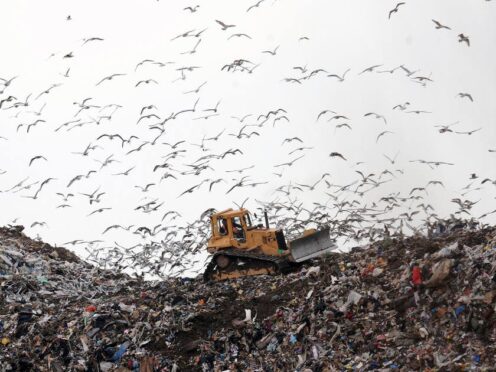
The Government is “off-track” to hit waste reduction targets, an industry trade body has warned, despite official statistics showing a drop in non-recyclable rubbish produced per person in England.
The Department for Environment, Food and Rural Affairs (Defra) released estimates on Thursday for the amount of waste produced in the country in 2022, as part of efforts to track progress against long-term and interim term targets set last year.
The figures include the kilograms of residual waste, excluding major mineral wastes (MMW), produced per person – also known as “black bag” waste.
This covers non-recyclable waste collected from households or businesses, but not construction or mining waste materials like concrete, sand and soil.
The data shows that residual waste dropped from 576.8kg per person in 2021 to 558.8kg per person in 2022, a 3.1% fall.
The Government’s interim target is for levels to reach 437kg per person in the most recent calendar year by January 31 2028 – the equivalent of a 21.8% decrease from 2022.
Meanwhile, the long-term target is no more than 287kg per person by December 31 2042: a 48.6% drop from 2022 levels.
The department also published estimates of the total mass of residual waste (excluding MMW) produced in England.
This stood at 31.9 million tonnes in 2022, down 2.2% from 32.6 million tonnes in 2021.
The Government’s target is for the total mass to be no higher than 25.5 million tonnes in the most recent calendar year by January 31 2028 – the equivalent of a 20.1% decrease on 2022.
The amount of residual waste per person sent to landfill fell by 4.7% between 2019 and 2022, while the amount put through incineration increased by 7.0%.
The total tonnage of residual waste in England sent to landfill saw a 3.2% drop over these three years, while the amount that was incinerated increased by 8.7%.
In recent years, Government plans to tackle the UK’s waste, such as the Deposit Return Scheme and Extended Producer Responsibility, have been beset by delays.
Jacob Hayler, executive director of the Environmental Services Association, said the figures “confirm that the UK Government is off-track to meet its target of near halving the amount of general waste produced per person by 2042”.
Mr Hayler also said the numbers suggest ministers stand “little chance” of hitting the 2028 interim goal.
“Although a 3% year-on-year decrease in waste volumes per person between 2021 and 2022 sounds positive, these figures include commercial waste volumes, which have likely naturally decreased in line with a weak economy,” he said.
“Today’s figures are unsurprising given the significant delays to Government’s flagship recycling reforms, which have yet to be implemented despite being announced in 2018.”
“Without major policy reform, the UK will not move the needle on flat-lining recycling rates, which have been static for a decade now.
“To stand a chance of hitting its targets, the Government must focus on delivering long-awaited packaging recycling reforms and should increase the plastic packaging tax to stimulate more market demand for recycled material.”
Mr Hayler also argued for local authorities in England to set longer-term statutory recycling targets, which have been rolled out in Wales, as “key to meeting national recycling and waste reduction goals”.
Meanwhile, Diane Crowe, sustainability director at circular economy firm Reconomy, said: “This data shines a spotlight on the amount of waste we are creating which cannot be recycled or reused and therefore must be sent to landfill or incineration.”
“These methods both have negative consequences for the environment, so it is encouraging to see the amount of residual waste produced is falling.
“Likewise, there has been a notable downtick over the past few years in the amount of residual waste sent to landfill, damaging ambitions of a more circular economy.
“The UK is clearly making good progress towards a more circular waste management model but there are powerful levers of change that the industry, working with government, must begin to pull to accelerate this transition.”
A Defra spokesperson said: “We need to cut the amount of our waste that ends up in landfill or being incinerated.
“These first-ever estimates for residual waste in England show that we are making progress against our long-term and interim targets.
“But we know that there is more to do, which is why we are pushing ahead with our programme of reforms to improve our use of resources, boost recycling and eliminate avoidable waste.”

Enjoy the convenience of having The Sunday Post delivered as a digital ePaper straight to your smartphone, tablet or computer.
Subscribe for only £5.49 a month and enjoy all the benefits of the printed paper as a digital replica.
Subscribe